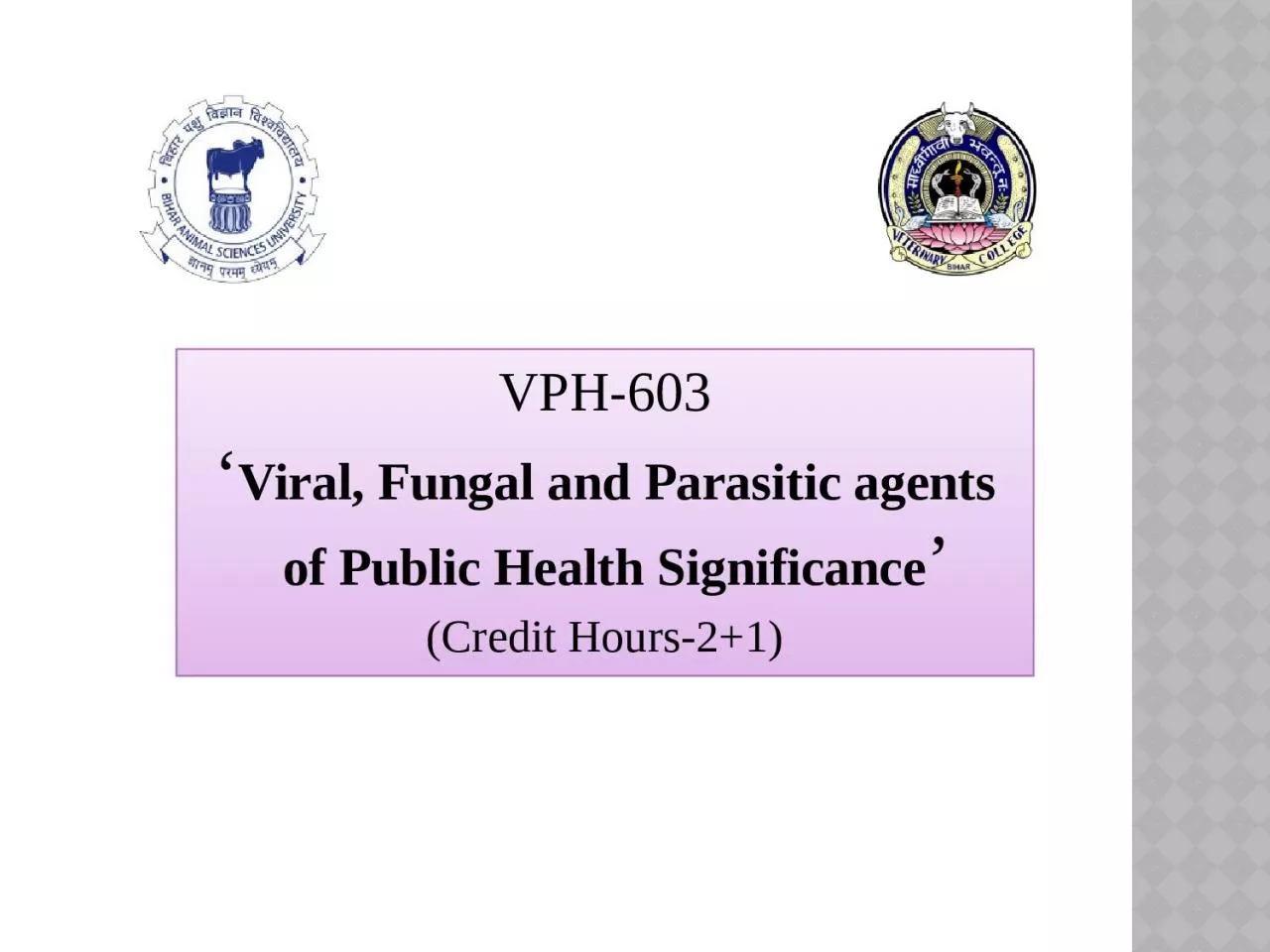

Credit Hours21 Kyasanur Forest disease KFD is a tick borne viral haemorrhagic fever caused by Flavivirus flaviviridae Introduction First identified in 1957 in ID: 932401
Download Presentation The PPT/PDF document "VPH-603 ‘ Viral, Fungal and Parasitic ..." is the property of its rightful owner. Permission is granted to download and print the materials on this web site for personal, non-commercial use only, and to display it on your personal computer provided you do not modify the materials and that you retain all copyright notices contained in the materials. By downloading content from our website, you accept the terms of this agreement.
Slide1
VPH-603‘Viral, Fungal and Parasitic agents of Public Health Significance’(Credit Hours-2+1)
Slide2Kyasanur Forest disease (KFD) is a tick borne viral haemorrhagic fever caused by
Flavivirus (flaviviridae)
Slide3IntroductionFirst identified in 1957 in Kyasanur forest, Sorab
taluka, Shimoga district of KarnatakaAlso k/as
haemorrhagic
fever
In
Kysanur
forest area-
Monkey fever
Endemic areas: Six districts of Karnataka (
Chamarajanagar
,
Chikkamagalore
,
Dakshina
Kannada,
Shimoga
,
Udupi
and
Uttara
Kannada) and
malappuram
of Kerala where each year during January–May, 100–500 persons are affected by the disease
Slide4EtiologyCaused by- Flavivirus (RNA genome)It shares the antigenic relationship with
1. Russian Spring Summer encephalitis 2. European Spring Summer encephalitis 3. Louping
ill
4. Omsk
haemorrhagic
fever
Slide5Host Range and VectorMajor wild life amplifier In endemic area-
Birds and Rodents play imp roleVector -Haemaphysalis spinigera
(most prominent),
Ixodes
Macaca
radiata
Presbytis
entellus
Ticks carry the virus in the
nymphal
and adult instars for up to 14 months
Man and domestic animals act as a dead end host
Slide6SeasonIn Monkeys-maximum mortality observed during the period of December to mayIn human- maximum cases were reported between the period of
January to JunePrevalence of disease is low in the rainy season
Age
Young and adult males
are more commonly affected
Sex
Males are more susceptible than female
Epidemiology
Slide7NATURAL CYCLEIn enzootic states the infection is maintained in small animals and also in ticksWhen monkeys comes in contact with infected ticks, they get infected, amplify and disseminate the infection in “hot spots
” of infectionHumans in these hot spots are infected by bite of infected anthrophilic ticks like
H.
spinigera
Slide8Transmission cycleViraemic birds play an important role in distant spread of virus and may also carry tick infected with virus
Slide9Disease in ManIncubation period: 3-8 daysSudden onset of fever, cephalagia, myalgia, anorexia, & insomniaOn 3-4 days patient tend to experience diarrhoea
& vomitingPapulovesicular lesions on the palate are a consistence findingsHamorrhages: in
poor
&
mal nourished
individuals
Neurological Signs-
neck rigidity, prostration, mental confusion,
Gastrointestinal & bronchial problems are commonCase fatality rate-
5-10%
Slide10Disease in AnimalsIn monkey-Diarrhoea, bradycardia & hypotensionIn diseased monkeys virus is present- Blood,
Liver, spleen, kidney, lung, heart, Skeletal muscles
The brain
Mortality:
during the high
viremic
stage
In
experimental cases-100%
fatality were noticed
Slide11DIAGNOSISBSL–3 facility is required for handling and workingSamples: Blood and serum, CSFIsolation: from blood during
febrile period or Organ samples collected during autopsy
Virus isolation
Cell lines
: BHK–21, Vero E6 cell lines
Animal inoculation
:
Embryonated
chick cell,
In mice
Serological Methods
:
ELISA
CF,
HI test
Neutralization test
Slide12TREATMENT No specific antiviral treatment Early hospitalization & supportive treatmentSupportive therapy- maintenance of normal blood cell counts, blood pressure
Symptomatic treatment: Pain reliefs,
Antipyretics,
Blood transfusion,
Antimicrobial therapy for secondary infections,
Nervous disorder
: Corticosteroids & anticonvulsants
Slide13LABORATORY HAZARDS Inhalation of aerosol: most frequent way of acquiring infection Other means of transmission includes: Conducting post mortem examination,Accidental
parentral inoculation,Spilling out of contents from broken glass wares orAccidental ingestion
Follow the WHO guideline while shipping of samples for diagnosis
Slide14PREVENTION AND CONTROL Prevention strategies such as:Quarantine,Vaccination,Early diagnosis,
Tick control will restrict the entry of virus to new areas Spray insecticides has been recommended in a 50-m radius around a dead monkeyOther control strategy- wearing protective clothing while handling infectious materials and tick control
Strictly prohibit the visit to affected forest areas during outbreak time
If visit is inevitable, use protective clothing’s and gum boots to cover the whole body and apply some insect repellent to exposed body part
Slide15VACCINATIONVaccines against KFDV were initially produced in Shimoga district of Karnataka. Later, the unit was moved to Bangalore (Institute of Animal Husbandry and Veterinary Biologicals)
The first vaccine: formalin-inactivated, mouse-brain preparation of Russian Spring Summer Encephalitis Virus (RSSEV) by ICMR due to the close antigenic resemblance of KFDV with RSSEV
3- dose schedule at 0, 7 and 42 days , SC
In 1990s, Formalin-inactivated chick embryo vaccine:
Haffkine
Institute in Bombay licensed and used in India
2 doses - one month apart
Age group: 7 to 65 years of age.
Vaccine-induced immunity is short-lived
Booster dose within
6 to 9 months
after primary vaccination
Annual booster doses for 5 years
Vaccine efficacy of 79.3% with 1 dose and 93.5% with 2 doses .
Slide16Government of Karnataka:The Directorate of Health and Family Welfare, Karnataka, vaccination campaigns: Formalin inactivated tissue culture vaccine in endemic districts
Villages reporting KFD activity (laboratory-confirmed cases in monkeys and/or humans, or infected ticks), and all villages within 5 km of the affected location are targeted for vaccination
If cases of KFD are reported in the area in spite of vaccination during the pre-transmission season, additional vaccination campaigns are conducted